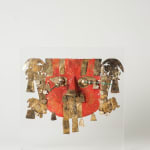Sican Culture
9'8" x 14'1" x 5'9" in.
Further images
-
(View a larger image of thumbnail 1
)

-
(View a larger image of thumbnail 2
)

-
(View a larger image of thumbnail 3
)

-
(View a larger image of thumbnail 4
)

-
(View a larger image of thumbnail 5
)

-
(View a larger image of thumbnail 6
)

-
(View a larger image of thumbnail 7
)

-
(View a larger image of thumbnail 8
)

-
(View a larger image of thumbnail 9
)

-
(View a larger image of thumbnail 10
)

Powerful dynasties arose in this region between the eighth and the fourteenth centuries A.D. and amassed great riches in gold and silver before they were conquered by the Inca Empire in the late fifteenth century. The lords of these dynasties were the patrons of vast workshops where finely crafted ornaments and ceremonial vessels were created. At death, the lords were buried deep in monumental mud-brick platform mounds along with large numbers of objects of precious metal, shell, and cloth. In addition to beakers, disks, and other ornaments, the burials included large masks made of sheet gold. As many as five masks were placed into one burial: one attached to the head of the textile-wrapped body, and the other four stacked at the feet of the deceased.













